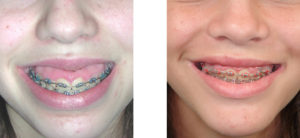In the ideal smile, the upper lip sits just at or above the top of the teeth. The general rule is that 1 to 2 millimeters of gum exposure with a maximal smile is aesthetically acceptable. When some people smile, however, a large gap becomes exposed between the lip and the upper teeth, exposing a lot of gum tissue and producing the so-called gummy smile. The gummy smile can be due to a variety of factors including a hyperactive muscle which lifts the upper lip too much, a thin upper lip which rolls under when smiling, gum tissue which covers too much of the upper teeth, and a long upper jaw. Careful examination of the smile, at rest and when smiling, can help identify which one(s) of these factors is contributing to the gummy smile problem.
The classic minimally invasive treatment is the excision of gum tissue also referred to as a gingivoplasty. The gingivoplasty is the removing of excess gum tissue from the top part of the teeth, making the tooth look longer and lessening the amount of gum tissue exposed between the lip and the teeth, One must be careful to not remove too much gum tissue which can expose the root portion of the tooth leading to chronic sensitivity. Occasionally dentalveneers can be used as part of this procedure to help increase the amount of tooth show.
Other minimally invasive procedures include the injectable treatments of Botox® and off-the-shelf fillers. Injecting Botox into the hyperactive muscles of the upper lip will reduce how much the upper lip moves upward resulting in less of a gummy smile. Like all Botox injections, however, the result will last at best for four months. But it can be tremendously useful in someone who has a big wide smile movement. If the upper lip is also thin, injectable fillers such as Juvaderm or Perlane can be added to help bring down the vermilion border (lower edge of the upper lip) slightly. These injectable fillers will last longer than Botox, lasting up to six to months. In a few cases, I have done both at the same time which overall creates a better effect than either one alone.
Another option to reduce a ‘high lip line’ is an upper lip lowering procedure. This minor operation was initially introduced in the 1970s but has only recently become more popular. It is done with a local anesthetic and involves the re-attachment of the gum tissue under the lip (this does not involve any surgery on the lip that you see) at a level that is closer to the teeth. This results in not only lowering the lip line at rest but also limiting how much it moves upward when smiling. This procedure shortens the depth of the vestibule (space between the upper lip and gum tissue high up under the lip) to help bring the lip down somewhat. This vestibuloplasty can also be combined with a V-Y mucosal lip lengthening which can bring down the position of the upper lip a few more millimeters.

The proper treatment of the gummy smile is based on a good evaluation to determine what anatomic problems is making it look so. Minor cosmetic changes can be done with gingivoplasty, injectable treatments, or a lip lowering procedure. Correction of large gummy smile requires maxillary bone shortening surgery.
Dr. Barry Eppley
Indianapolis, Indiana


